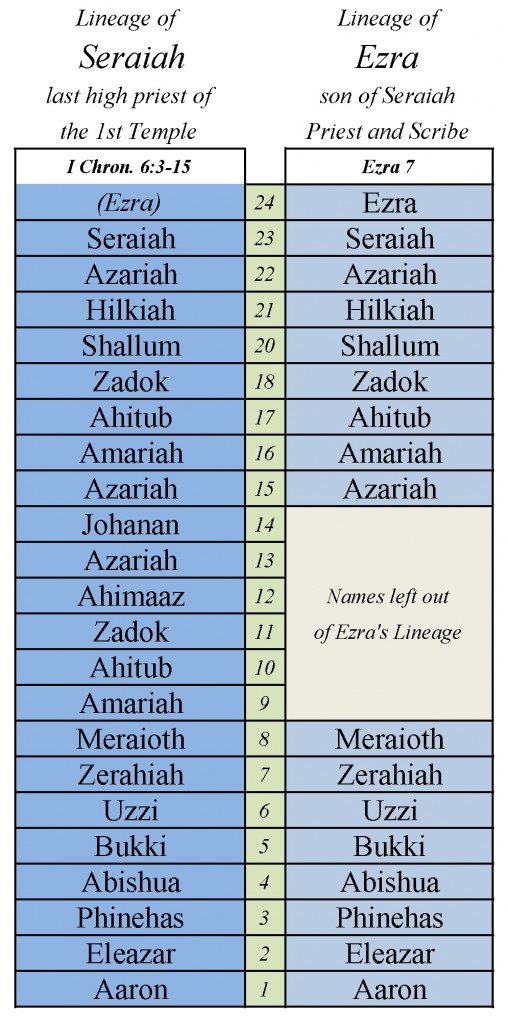 During the 2nd temple period, few Old Testament characters hold a more prominent position than Ezra. The Bible identifies him as a Priest and Scribe. It is believed that he was the author of both the book of Ezra as well as Chronicles. Both of these accounts provide a vivid record of the triumphs and tragedies of the Judean captives’ efforts in rebuilding the 2nd temple and Jerusalem. After the completion of the temple in the 6th year of Darius, Ezra, who still resided in Persia, saw the need to return to Jerusalem and teach the people the law of YHWH.
During the 2nd temple period, few Old Testament characters hold a more prominent position than Ezra. The Bible identifies him as a Priest and Scribe. It is believed that he was the author of both the book of Ezra as well as Chronicles. Both of these accounts provide a vivid record of the triumphs and tragedies of the Judean captives’ efforts in rebuilding the 2nd temple and Jerusalem. After the completion of the temple in the 6th year of Darius, Ezra, who still resided in Persia, saw the need to return to Jerusalem and teach the people the law of YHWH.
Today, the chronology of Ezra is an important cornerstone for most of today’s teachings on Daniel 9, the greatest Messianic prophecy in the Bible. Daniel 9, also known as the prophecy of “seventy weeks,” is the only prophecy in the Bible that specifically links a dateable secular event with the coming of the Messiah. Daniel 9:25 states the following:
Daniel 9:25 25 Know therefore and understand, that from the going forth of the commandment to restore and to build Jerusalem unto the Messiah the Prince shall be seven weeks,
Without the chronology of Ezra, there would be no way to determine the starting point for “the commandment to restore and to build Jerusalem.” (For more on the subject see my articles The Fifth Command and The “Artaxerxes Assumption”.) Considering the importance of Ezra’s writings to our understanding of the Seventy Weeks prophecy you might assume this Old Testament chronology would be well established upon a reasonable Biblical basis. For those who have taken the time to look, you will find instead it is one of the best kept secrets of Old Testament chronology.
Do you find that hard to believe? I encourage you to see for yourself. Choose any of today’s most respected teachers on the prophecy of Seventy Weeks and see what reasonable Biblical evidence they provide to show Ezra was a contemporary of “Artaxerxes” Longimanus. To be sure you will find their “Artaxerxes Assumption” but what you will not find is any reasonable Biblical evidence to support it.
So what does the Bible say about Ezra?
It may surprise you to learn there is substantial Biblical evidence to determine Ezra’s place in 2nd temple era chronology. Probably the best place to start is in the beginning.
Ezra 7:1 Now after these things, in the reign of Artaxerxes king of Persia, Ezra the son of Seraiah, the son of Azariah, the son of Hilkiah,
In the verse above, it says that Ezra was the son of Seraiah. What’s fascinating about this statement is Seraiah, son of Azariah, was the last high priest of Solomon’s temple. 2 Kings 25:8-21 tells us that Seraiah was taken by Nebuzaradan to Riblah in the 19th year of Nebuchadnezzar and there he was killed.
2 Kings 25:1-21 8 And in the fifth month, on the seventh day of the month, which is the nineteenth year of king Nebuchadnezzar king of Babylon, came Nebuzaradan, captain of the guard, a servant of the king of Babylon, unto Jerusalem: 9 And he burnt the house of YHWH, and the king’s house, and all the houses of Jerusalem, and every great man’s house burnt he with fire. 10 And all the army of the Chaldees, that were with the captain of the guard, brake down the walls of Jerusalem round about. 11 Now the rest of the people that were left in the city, and the fugitives that fell away to the king of Babylon, with the remnant of the multitude, did Nebuzaradan the captain of the guard carry away………..18 And the captain of the guard took Seraiah the chief priest, and Zephaniah the second priest, and the three keepers of the door…………. 20 And Nebuzaradan captain of the guard took these, and brought them to the king of Babylon to Riblah: 21 And the king of Babylon smote them, and slew them at Riblah in the land of Hamath. So Judah was carried away out of their land.
I think most everyone would agree, it is reasonable to assume that Ezra could not have been conceived after the death of his father, Seraiah. Let’s further assume, for the sake of argument, that Ezra was born the year his father was killed. (Not really a reasonable assumption considering the events that took place in Jerusalem but it’s the earliest he could have been born so let’s go with it) The 19th year of Nebuchadnezzar by many accounts was 584 BC.
Ezra 7:1-8 Now after these things……… This Ezra went up from Babylon;……. unto Jerusalem, in the seventh year of Artaxerxes the king. 8 And he came to Jerusalem in the fifth month, which was in the seventh year of the king.
In order to establish Ezra’s place in the chronology of the 2nd Temple era all we now need to do is determine the date for the 7th year of “Artaxerxes”. If you’ve read my articles The Fifth Command and The “Artaxerxes Assumption you know that the term “Artaxerxes” is simply a title which was applied to several Persian kings. For the sake of brevity, I will not list all the possible Persian Artaxerxes, only those whose reign lasted at least 32 years as required by Nehemiah 5:14. Those Persian kings are Darius “the Great” Artaxerxes, Artaxerxes Longimanus, and Artaxerxes Memnon. With the above information, it is a simple matter to calculate Ezra’s minimum age during the reign of “Artaxerxes”. In the table below you will see the youngest Ezra could have been in the 7th year of each “Artaxerxes”. Please keep in mind that Ezra was also alive 14 year later at the dedication of the wall in Jerusalem and took an active part in those ceremonies.
The question is simple: Which of the above Persian Kings most reasonably qualifies as a contemporary of Ezra? Keep in mind the words of king David:
Psalm 90:9-10 9 For all our days are passed away in thy wrath: we spend our years as a tale that is told. 10 The days of our years are threescore years and ten; and if by reason of strength they be fourscore years, yet is their strength labour and sorrow; for it is soon cut off, and we fly away.
In my next article, Ezra the Priest and Scribe – Part II we will look at the chronology of Ezra 6 &7. What does the Bible say about the 7th year of “Artaxerxes” and who does it identify as this “Artaxerxes”? Why is this relevant to the prophecy of Seventy Weeks?
More Articles related to the prophecy of 70 Weeks and 2nd temple era chronology:
The “Artaxerxes” Assumption – The best kept secret of Old Testament chronology.
The Fifth Command – Why do prophecy teachers ignore it?
Ezra: Priest & Scribe – Part I – Defining “Artaxerxes” in the context of Ezra.
Ezra: Priest & Scribe – Part II – Ezra, Darius even “Artaxerxes”.
Nehemiah: The Governor– Nehemiah’s place in the 2nd temple chronology
Queen of Persia – Part I – Defining Esther is the context of the 2nd Temple era.
Queen of Persia – Part II – Defining Esther is the context of the 2nd Temple era.
A New Testament Cipher – The key to unlocking the prophecy of Daniel’s 70 Weeks.
Ezekiel’s 13th Month– Key to understanding Biblical “time” in the 2nd Temple era
6 milestones – Seventy Weeks – Defining the purpose of the Messiah within Daniel’s 70 “weeks”.
The Messiah Factors (Part I): Decoding 13 & 14 – Symbolism of the Messiah
The Messiah Factors (Part II): The Countdown – Proving Yeshua/Jesus is the Messiah promised in Daniel 9.






